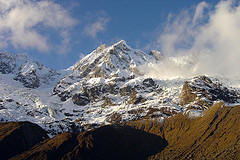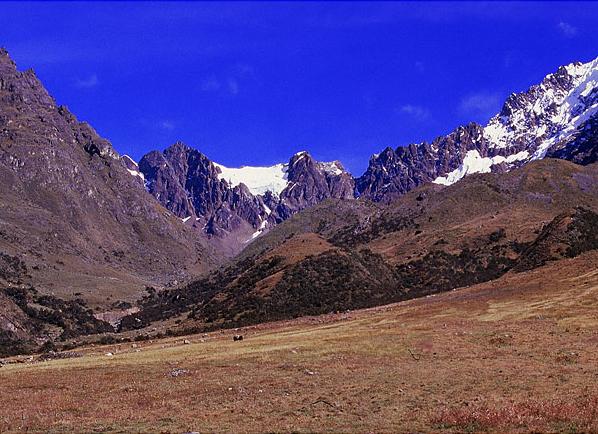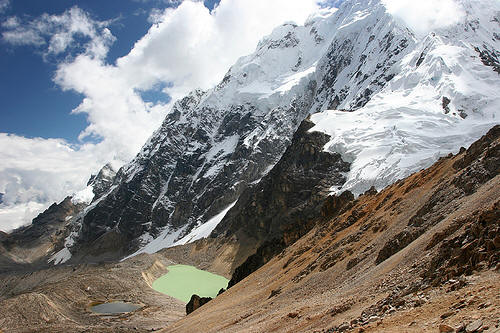Nevado Salkantay (or Salcantay) is actually a mountain. It is the highest peak of the Cordillera Vilcabamba. Cordillera Vilcabamba is a part of the Peruvian Andes. Salcantay is within Cusco Region. This peak is 40 miles north west of Cusco city.  Salcantay or Salkantay trek is the second most popular trek in Peru. Lot of people choose this trek now a days. You will pass through more scenic places in this trek. This one is bit more challenging too. You need to be physically a little more stronger for this trek. Acclimatization is also very important here as you have to pass through 15,250 ft. Some people like it very much because it is not over crowded like classic Inca trail.  If you can book three months in advance then you can hike the one which enters regulated Inca trail. Route of which is Mollepata - Salkantay - Wayllabamba - Machu Picchu. Here at Wayllabamba trek merges with regulated Inca trail. But if you haven't book yet anything, and you are still planning to hike Inca trail then you may go for the alternative one. Route for this alternative one is Mollepata- Salkantay - Santa Teresa - Machu Picchu. Here after Santa Teresa you will reach Hydroelectric power plant, then Aguas Calientes, and finally Machu Picchu. Since you are not entering regulated Inca trail, so booking is not a headache as time constraint does not apply here. You can tour anytime, with a suitable tour operator.  Salkantay Trek, with the Salkantay peak at behind - Mollepata - Salkantay - Wayllabamba - Machu Picchu
27 mile Trek This one is usually a seven day tour. Since it enters original Inca trail at Wayllabamba, you need to by the Inca trail permit for this trek. So because of time restriction or space restriction you have to book a space few months in advance. You will start from Mollepata. Usually the tour operators will take you by bus or car to Mollepata, which is a 3 and half hours drive from Cusco city. Second day you will reach Soraypampa from where you can see the beautiful snowcapped Salkantay peak. On fifth day you will join up with the Inca Trail at Wayllabamba and continue to Machu Picchu. Horses are used here to carry food and equipment. But when you join original Inca Trail, human porters are back for this purpose 
36 mile Trail Suppose you are in Lima or in Cusco and you want to hike Inca trail. So it may not be possible to get a space within such short time. In that case you may visit this trek. This is usually a five day tour. Government has not yet impose any permit requirement on this trails, hence there is no space limitations on this trails. That is why you may easily arrange a tour on this trails. Like the other one you have to start from Mollepata. Second day you will stop at Soraypampa. On third day you will pass beautiful Salkantay pass. Some tour operators camp on the foot of Salkantay on third day. Others stop at Santa Teresa town on third day. There is a hot spring around this place. You may be arranged to have bath on the hot spring. Fourth day you will cross Urubamba river and reach hydroelectrica of Machu Picchu. From this place a local train will take you to Aguas Calientes(8 km journey). Train journey is around one hour. Fourth night you will stay at Aguas Calientes town. Fifth and final day is for roaming in Machu Picchu. On fifth day after visiting Machu Picchu you will come back to Cusco by train. Expanses of the tour depends on mainly the size of the group. 5 day tour is relatively cheap, as it is not included the expenses of Inca trail permit ( permit is not required here). Also less number of lunch and dinner are supplied. As Inca trail restrictions are not applied to this trek, tour operators can use less number of porter and cook. Usually they ask something in between 400$ & 600$, depending on the quality of the service and the number of persons in a group. They even start with two people as a group.  7 days tour is naturally more expensive. Extra days, Inca trail permit, extra lunch and dinner, and because of government regulation in this trek they have to use more porters and cooks. Usually you will be asked to pay between 1100$ & 1500$. As Salcantay trek is not regulated by the government rule, quality is a concern here. I hope you know why government had to implement the new rule for the Inca trail. Less quality guides, overburdened porters, improper sanitary arrangement- all these things were once associated with Inca Trail. These are the things now occurring at Salcantay trail. So if you decide to go for Salcantay trail, don't try to catch a cheap operator. Here cheap means you will lose quality. You will pass through 15,000 ft in this trek. So acclimatization is a major concern here. Don't start without spending at least two nights at Cusco. Some tour operators warn, " trekker needs to be acclimatized beforehand, and if he or she become effected while trekking, he/she has to go downhill himself/herself, alone." Few other operators keep arrangements with extra saddle horses, so that the trekker can be rescued. So before you chooses an operator check these things. And must stay at least 2 days in Cusco before you start. Read my page on acclimatization. | 





